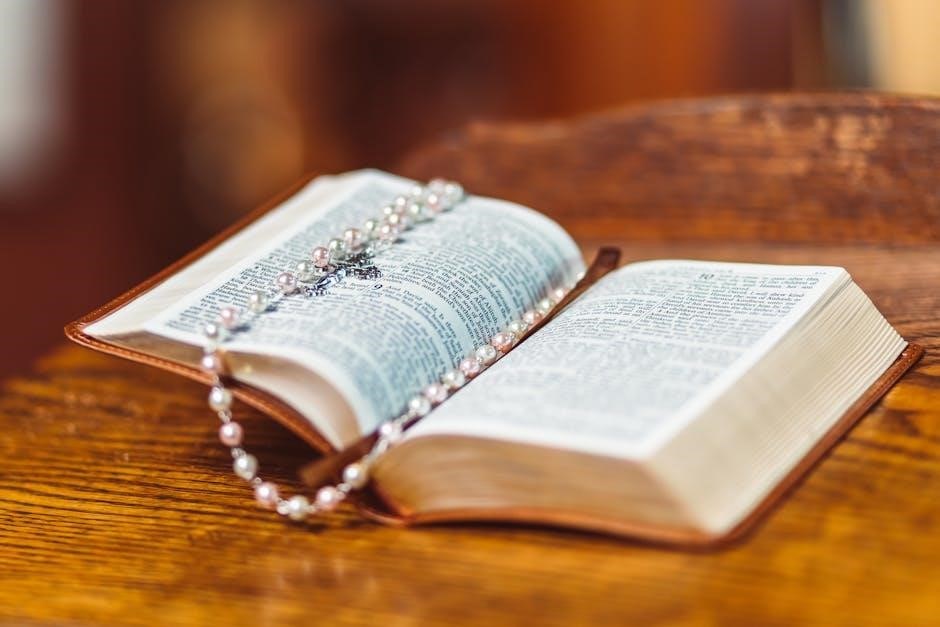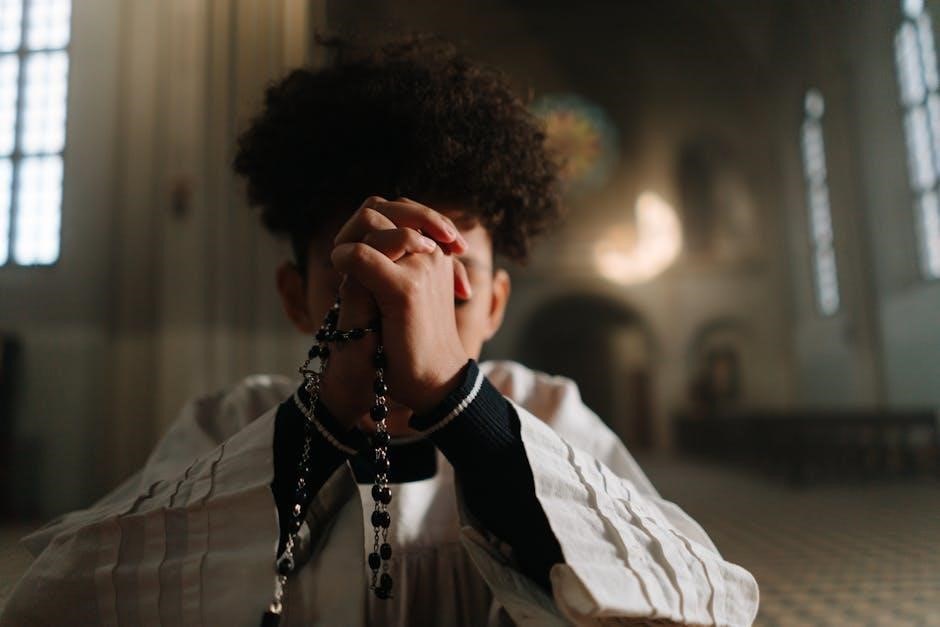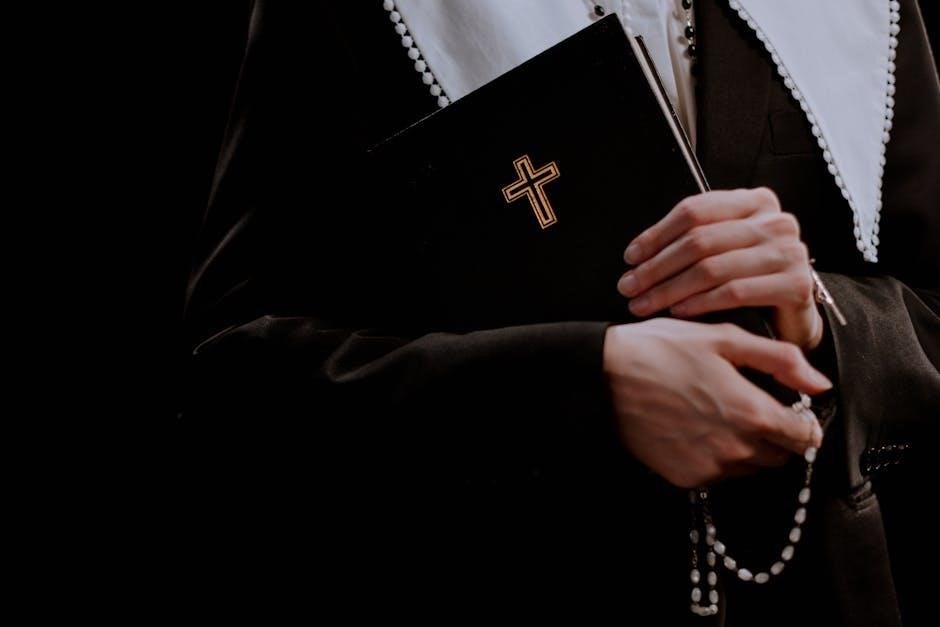Holy Rosary Thursday PDF: A Comprehensive Guide
This comprehensive guide provides a structured approach to understanding and praying the Holy Rosary, specifically focusing on Thursdays. It includes step-by-step instructions, prayers, and reflections on the Luminous Mysteries. Resources for downloading a Holy Rosary Thursday PDF are included, with additional information on the prayers.
The Holy Rosary is a Scripture-based prayer, deeply rooted in Catholic tradition, and a powerful means of connecting with God. It is a contemplative prayer that combines vocal prayer with meditation on the mysteries of the lives of Jesus Christ and the Virgin Mary. The Rosary begins with the Apostles’ Creed, summarizing the core beliefs of the Catholic faith, followed by the Our Father, Hail Mary, and Glory Be prayers.
The Rosary involves meditating on specific mysteries that reflect key moments in the lives of Jesus and Mary. These mysteries are traditionally divided into four sets: Joyful, Sorrowful, Glorious, and Luminous. Each set contains five mysteries, and praying the Rosary typically involves meditating on one set of mysteries.
The Rosary is more than just reciting prayers; it is an invitation to enter into a deeper relationship with Jesus and Mary. By meditating on the mysteries, we seek to understand their significance and apply their lessons to our own lives. The Rosary is a powerful tool for spiritual growth, offering solace, guidance, and strength in our daily lives.
Through the intercession of the Blessed Virgin Mary, we can draw closer to Christ and experience the transformative power of prayer.
The Significance of Thursday in Rosary Prayer
In the traditional practice of praying the Holy Rosary, each day of the week is associated with a particular set of mysteries, offering a focused lens through which to contemplate the life of Jesus Christ. Thursday holds a special significance as the day dedicated to meditating on the Luminous Mysteries, also known as the Mysteries of Light. These mysteries highlight key moments in Jesus’ public ministry, revealing His divine mission and the unfolding of God’s kingdom.
The Luminous Mysteries, introduced by Pope John Paul II in 2002, bridge the gap between Jesus’ hidden life and His Passion, Death, and Resurrection. They invite us to reflect on Jesus’ baptism in the Jordan, the wedding at Cana, His proclamation of the Kingdom, the Transfiguration, and the Institution of the Eucharist.
Praying the Rosary on Thursday, focusing on the Luminous Mysteries, allows us to delve deeper into the understanding of Christ’s ministry, His teachings, and His miracles. It is a time to contemplate His role as the Light of the World, illuminating the path to salvation. This practice enhances our spiritual journey, deepening our faith and commitment to following Christ’s example in our daily lives.
Luminous Mysteries: The Focus of Thursday Rosary
The Luminous Mysteries, also known as the Mysteries of Light, are central to the Holy Rosary when prayed on Thursdays. These mysteries, introduced by Pope John Paul II, illuminate significant moments in Jesus Christ’s public ministry, offering profound insights into His divine nature and mission.
The first Luminous Mystery is the Baptism of Jesus in the Jordan, where He is revealed as the beloved Son of God. The second is the Wedding at Cana, where Jesus performs His first miracle, manifesting His glory. The third is the Proclamation of the Kingdom, where Jesus calls all to repentance and faith. The fourth is the Transfiguration, where Jesus reveals His divine glory to His disciples. The fifth and final Luminous Mystery is the Institution of the Eucharist, where Jesus gives us the sacrament of His Body and Blood.
By meditating on these mysteries each Thursday, we gain a deeper understanding of Jesus’ life and teachings. We are invited to contemplate His role as the Light of the World, guiding us towards salvation. Through the Luminous Mysteries, we strengthen our faith, deepen our love for Christ, and grow in our commitment to living out the Gospel message in our daily lives. The focus is on Christ.
Prayers of the Rosary: A Step-by-Step Guide
Praying the Rosary involves a structured sequence of prayers and meditations. Begin with the Sign of the Cross, stating, “In the Name of the Father, and of the Son, and of the Holy Spirit. Amen.” Follow this with the Apostles’ Creed, a declaration of faith.
Next, pray the Our Father on the first large bead. Then, on the subsequent three small beads, recite the Hail Mary prayer three times, focusing on increasing faith, hope, and charity. Conclude this initial sequence with the Glory Be prayer.
Now, begin the five decades. For each decade, announce the mystery (e.g., “The Baptism of Jesus”). Pray the Our Father on the large bead, followed by ten Hail Mary prayers on the ten small beads. After each decade, pray the Glory Be and the Fatima Prayer (“O my Jesus, forgive us our sins…”).

Repeat this process for all five decades, meditating on each mystery. After the final decade, conclude with the Hail, Holy Queen prayer. Optionally, add concluding prayers such as “Pray for us, O Holy Mother of God,” and a final prayer for grace. End with the Sign of the Cross. This structured approach provides a framework for prayer.
Sign of the Cross and Apostles’ Creed
The Rosary begins with two foundational prayers: the Sign of the Cross and the Apostles’ Creed. The Sign of the Cross is a powerful declaration of faith in the Holy Trinity. To make the Sign of the Cross, touch your forehead, then your chest, then your left shoulder, and finally your right shoulder, while saying, “In the Name of the Father, and of the Son, and of the Holy Spirit. Amen.” This simple act acknowledges God’s presence and invites His blessing upon the prayer that follows.
Following the Sign of the Cross, the Apostles’ Creed is recited. This creed is a concise summary of core Christian beliefs, affirming faith in God the Father, Jesus Christ His Son, and the Holy Spirit. It outlines key doctrines such as the Virgin Birth, the Passion, Death, and Resurrection of Jesus, His ascension into Heaven, and His eventual return. Reciting the Apostles’ Creed sets the stage for deeper contemplation on the mysteries of the Rosary, grounding the prayer in fundamental truths. This prayer proclaims belief in the Holy Spirit, the holy Catholic Church, the communion of saints, the forgiveness of sins, the resurrection of the body, and life everlasting.
The Our Father and Hail Mary Prayers
The Our Father, also known as the Lord’s Prayer, holds a central place in the Rosary. Taught by Jesus himself, it expresses adoration for God and petitions for daily needs, forgiveness, and protection from evil. Each decade of the Rosary begins with the Our Father, signifying the importance of seeking God’s will and guidance before delving into the mysteries. We humbly ask our “Father, who art in Heaven,” to provide for our needs and lead us away from temptation.
The Hail Mary, the most repeated prayer in the Rosary, honors the Virgin Mary. It combines the Angel Gabriel’s greeting to Mary at the Annunciation (“Hail, Mary, full of grace, the Lord is with thee”) with Elizabeth’s blessing at the Visitation (“Blessed art thou among women, and blessed is the fruit of thy womb, Jesus”). The prayer concludes with a petition, “Holy Mary, Mother of God, pray for us sinners, now and at the hour of our death.” This prayer acknowledges Mary’s unique role in salvation history and seeks her intercession for our spiritual well-being. It is a powerful act of devotion to the Mother of God.
Glory Be and Fatima Prayer
The “Glory Be” is a short doxology, a prayer of praise to the Holy Trinity: “Glory be to the Father, and to the Son, and to the Holy Spirit. As it was in the beginning, is now, and ever shall be, world without end. Amen.” This prayer affirms the eternal nature of God and expresses gratitude for his divine essence. It is recited after each decade of Hail Marys, providing a moment to refocus on God’s glory amidst the meditation on the mysteries of the Rosary.

The Fatima Prayer, also known as the “O My Jesus” prayer, is a petition for forgiveness and salvation. It originated from the apparitions of Our Lady of Fatima in 1917. The prayer is: “O my Jesus, forgive us our sins, save us from the fires of hell; lead all souls to Heaven, especially those in most need of Thy mercy.” This prayer is a plea for divine mercy and a reminder of the importance of praying for the salvation of all souls. It is often recited after the Glory Be, adding a layer of supplication to the Rosary.
Praying the Luminous Mysteries on Thursday
Thursdays are traditionally dedicated to meditating on the Luminous Mysteries, also known as the Mysteries of Light. These mysteries focus on key events in Jesus’ public ministry, highlighting his role as the light of the world. Praying these mysteries involves reflecting on five specific events: The Baptism of Jesus in the Jordan, The Wedding Feast at Cana, The Proclamation of the Kingdom of God, The Transfiguration, and The Institution of the Eucharist.
Each Luminous Mystery offers unique insights into Jesus’ mission and divine nature. During the Baptism, we witness the Holy Spirit descending upon Jesus, marking the beginning of his public ministry. At the Wedding Feast at Cana, Jesus performs his first miracle, revealing his power and compassion. The Proclamation of the Kingdom emphasizes Jesus’ teachings and call to conversion. The Transfiguration unveils Jesus’ divine glory to his disciples, and The Institution of the Eucharist establishes the sacrament of communion.
When praying the Luminous Mysteries, take time to contemplate the significance of each event and how it relates to your own spiritual journey. Allow the light of Christ to illuminate your heart and guide you towards a deeper understanding of God’s love and grace.
The First Luminous Mystery: The Baptism of Jesus
The first Luminous Mystery is the Baptism of Jesus in the Jordan River by John the Baptist. This event marks the beginning of Jesus’ public ministry and reveals profound theological truths. As Jesus descends into the water, he identifies himself with humanity, taking on the burden of our sins. The heavens open, and the Holy Spirit descends upon him in the form of a dove, symbolizing divine approval and empowerment.

A voice from heaven proclaims, “This is my beloved Son, with whom I am well pleased,” affirming Jesus’ divine sonship and his mission to redeem humanity. The Baptism is not only a symbolic cleansing but also an anointing, setting Jesus apart for his Messianic role. This mystery invites us to reflect on our own baptism and the call to follow Christ.
We consider how we can better live out our baptismal promises, renouncing sin and embracing a life of faith, hope, and charity. Meditating on the Baptism of Jesus reminds us of God’s unwavering love and the power of the Holy Spirit to transform our lives. It is a call to discipleship and a reminder of our identity as children of God.
Concluding Prayers of the Rosary
After meditating on the five decades of the Rosary, specific concluding prayers bring the devotion to a close, reinforcing the petitions and reflections made during the prayer. These prayers typically begin with the “Hail, Holy Queen,” a heartfelt plea to the Blessed Virgin Mary, seeking her intercession and guidance. This prayer acknowledges Mary as our advocate, helper, and mediatrix, entrusting ourselves to her maternal care.
Following the “Hail, Holy Queen,” a dialogue often takes place, with the leader reciting “Pray for us, O Holy Mother of God,” and the response being “That we may be made worthy of the promises of Christ.” This exchange emphasizes Mary’s role in leading us closer to Jesus and helping us attain eternal life. A concluding prayer, often beginning with “O God, whose only-begotten Son,” then follows.
This prayer acknowledges that through Jesus’ life, death, and resurrection, we have been purchased the rewards of eternal life. It beseeches God to grant that, by meditating on these mysteries, we may imitate what they contain and obtain what they promise. The Rosary typically ends with the Sign of the Cross, affirming our faith in the Holy Trinity and our commitment to living as disciples of Christ, concluding the Rosary prayer.
Hail Holy Queen Prayer
The “Hail, Holy Queen” (Salve Regina in Latin) is a cherished Marian prayer traditionally recited at the conclusion of the Rosary. It serves as a heartfelt plea to the Blessed Virgin Mary, seeking her intercession and assistance. This prayer acknowledges Mary’s queenship and her role as a mother of mercy, offering solace and hope to those who turn to her in faith.
The prayer begins by addressing Mary as “Hail, Holy Queen, Mother of Mercy,” immediately establishing her as a figure of both royalty and compassion. It continues by acknowledging her as “our life, our sweetness, and our hope,” emphasizing the vital role she plays in our spiritual journey. We cry out to her, “To thee do we cry, poor banished children of Eve,” recognizing our earthly exile and our need for her guidance.
The prayer further beseeches Mary to turn her “eyes of mercy” toward us and, after our earthly exile, to show us “the blessed fruit of thy womb, Jesus.” This plea encapsulates the ultimate goal of our faith: to be united with Christ in eternal life. The prayer concludes with the repeated invocation, “O clement, O loving, O sweet Virgin Mary,” underscoring her virtues and our unwavering trust in her intercession. This prayer encapsulates our love for Mary.
Resources for Holy Rosary Thursday PDF
For those seeking a structured guide to praying the Holy Rosary on Thursdays, focusing on the Luminous Mysteries, several resources offer downloadable PDFs. These PDFs typically include the prayers, the mysteries with accompanying Scripture passages, and sometimes, reflections to aid in meditation;

Many Catholic websites and organizations provide free Rosary guides in PDF format. These resources are easily accessible and can be downloaded for personal use or for group prayer settings. Search terms such as “Holy Rosary Thursday PDF,” “Luminous Mysteries Rosary PDF,” or “Rosary prayer guide PDF” will yield numerous options.
Some PDFs offer a simple, text-based format, ideal for those familiar with the Rosary. Others include images, artwork, or more detailed explanations, catering to those who are new to the Rosary or prefer a more visually engaging experience. Consider exploring different options to find a PDF that best suits your individual needs and preferences.
In addition to general Rosary guides, some resources may offer specific PDFs tailored for Thursday Rosary prayers, including reflections on the Luminous Mysteries and guidance on how to incorporate them into your prayer.
